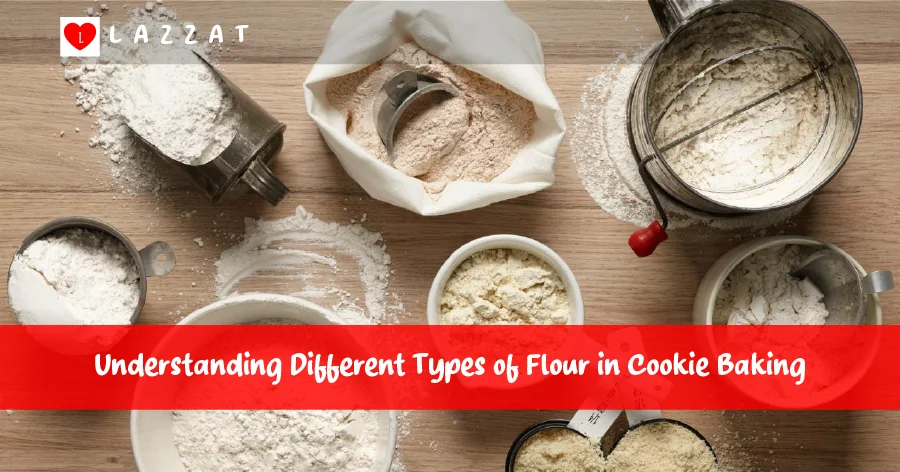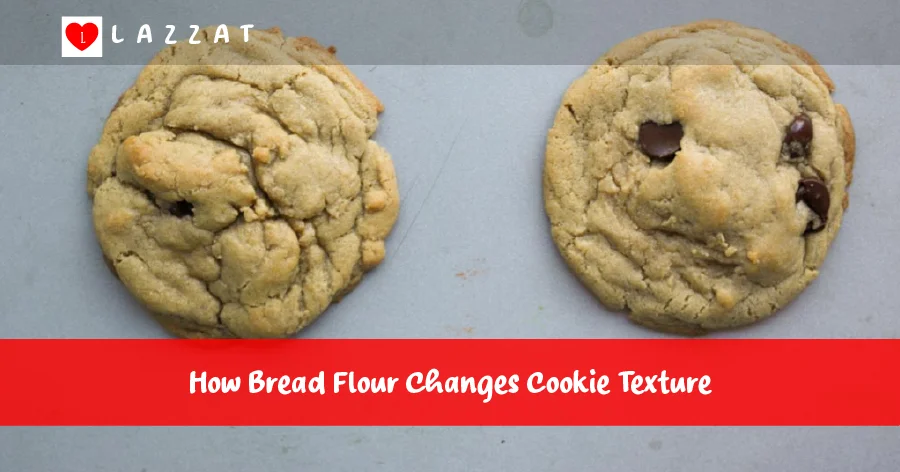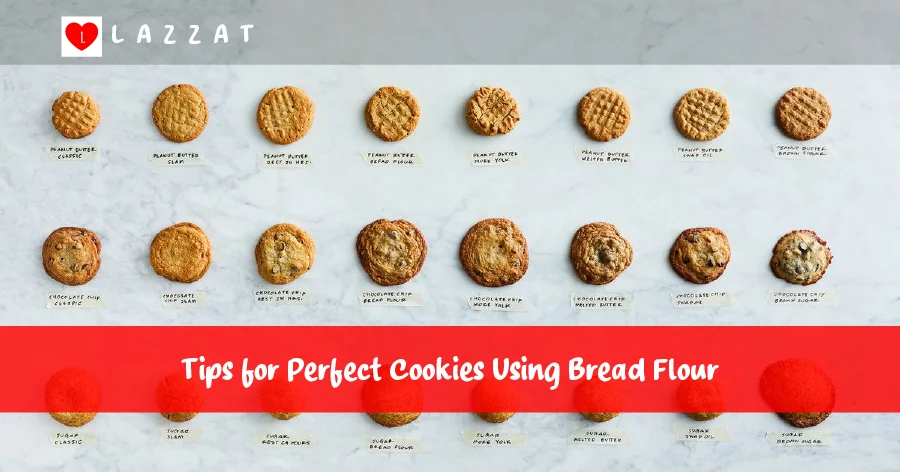Can Bread Flour Be Used For Cookies?
- mylazzat
- Bread Flour, Cookies
- 0 Comments
The type of flour you choose can change how your cookies turn out. All-purpose flour is common for cookies, but can bread flour work too? This guide will look at the differences between bread flour and all-purpose flour. It will also talk about how they affect cookie texture and how to adjust recipes for the best results with bread flour.
If you love baking, you might wonder about using bread flour for cookies. This guide will explain the science behind flour and how it affects cookie texture. It will also show you how to make sure your bread flour cookies are perfect. Whether you’re experienced or new to baking, this article will help you use bread flour in your cookie recipes with confidence.
Table of Contents
Understanding Different Types of Flour in Cookie Baking
The type of flour you pick can change how your cookies turn out. All-purpose flour and bread flour are two common choices. Knowing the differences between them can help you pick the right one for your cookies.
All-Purpose vs. Bread Flour Properties
All-purpose flour is great for many baked goods, including cookies. It has a protein level of 8 to 11 percent. This balance makes cookies tender yet structured.
Bread flour, with 12 to 14 percent protein, makes cookies chewier and more structured. This is because it has a stronger gluten network.
Protein Content Comparison
- All-purpose flour: 8-11% protein
- Bread flour: 12-14% protein
Gluten Development in Different Flours
The flour’s protein content affects gluten development. Gluten is key for a cookie’s texture and structure. All-purpose flour creates a delicate gluten network, making cookies tender and soft.
Bread flour, with more protein, forms a stronger gluten network. This makes cookies chewier and more structured. However, it can also affect how the dough spreads and rises during baking.
Knowing about flour properties, protein content, and gluten development helps you choose the best flour for your cookies.

Can Bread Flour Be Used For Cookies?
Choosing the right flour is key when baking cookies. All-purpose flour is often the first choice, but can bread flour work too? The answer is yes, but there are some things to keep in mind.
Bread flour has more protein than all-purpose flour. This means it can make cookies chewier and more structured. But, it can also make them tougher, drier, and more likely to spread while baking.
- Pros of using bread flour for cookies:
- Can create a chewier, more structured texture
- Suitable for cookies that benefit from a higher protein content, such as chocolate chip or oatmeal cookies
- Cons of using bread flour for cookies:
- This may result in tougher, drier cookies
- Increased risk of excessive spreading during baking
Whether bread flour is good for cookies depends on the recipe and texture you want. If you decide to use it, you might need to adjust the recipe. This could mean less mixing or more liquid. Always start small and tweak as you go to get it just right.
The Science Behind Bread Flour in Cookie Making
Choosing the right flour is key to making great cookies. Bread flour, often seen as unusual, can actually enhance your baking. It opens up new possibilities in the kitchen.
How Protein Affects Cookie Texture
Bread flour has more protein, between 12-14%. This is higher than all-purpose flour’s 10-12%. More protein means more gluten, leading to chewier cookies.
Gluten Formation During Mixing
When you mix bread flour, it forms more gluten than all-purpose flour. This makes cookies stronger and less likely to spread too much. They keep their shape better.
Impact on Cookie Spread and Rise
| Flour Type | Cookie Spread | Cookie Rise |
|---|---|---|
| All-Purpose Flour | Typically more spread | Moderate rise |
| Bread Flour | Less spread | Higher rise |
Bread flour’s extra protein and gluten make cookies less spread and higher. They become chewier and more substantial.
How Bread Flour Changes Cookie Texture
If you love baking, you might have seen how bread flour changes cookie texture. It has more protein than all-purpose flour. This makes cookies feel and look different.
Using bread flour makes cookies chewier. The extra protein in bread flour makes more gluten. This gives cookies a chewy texture that’s great for chocolate chip or oatmeal cookies.
Cookies made with bread flour also get crisper on the outside. The gluten and protein make a crackly crust. This is perfect for cookies like biscotti or shortbread.
But, bread flour cookies might feel denser than those with all-purpose flour. The extra protein and gluten can make them feel more substantial. It’s up to you to decide if you like this texture better. Trying different flours can help you find your favorite.
“The key to mastering bread flour in cookie baking is understanding how the increased protein content affects the final texture. With a little trial and error, you can harness the unique properties of this flour to create truly exceptional baking tips.”

Adjusting Cookie Recipes When Using Bread Flour
If you love baking and trying new flour, you might wonder: can I use bread flour for cookies? Yes, you can, but you’ll need to tweak your recipe a bit. Let’s look at how to make sure your bread flour cookies are perfect.
Liquid Ratio Modifications
Bread flour has more protein than all-purpose flour, so it absorbs more liquid. When you swap bread flour for all-purpose in a cookie recipe, add 2-4 tablespoons more liquid. This keeps your cookies moist and prevents them from being too dry or crumbly.
Mixing Time Considerations
Bread flour’s higher gluten content means you need to mix the dough longer. Mix it for 1-2 minutes more than you would with all-purpose flour. This ensures your cookies are chewy and have a nice structure.
Temperature Adjustments
Because of the extra protein and gluten, you might need to bake at a lower temperature. Try baking at 25-50°F (14-28°C) lower and for 2-5 minutes longer. This helps prevent cookies from spreading too much or getting too brown.
With these simple changes, you can use bread flour in your cookie recipes. It adds a special texture and flavor. Remember, baking is all about trying new things. So, don’t hesitate to experiment and find the best cookie recipes for you.
Best Cookie Types to Make with Bread Flour
Baking cookies can be a fun adventure, and the flour you choose is key. All-purpose flour is great, but bread flour can make your cookies special. So, can you use bread flour for cookies? Absolutely!
Bread flour’s high protein content makes cookies chewy and sturdy. Here are some top cookie types to try with bread flour:
- Chocolate Chip Cookies – Bread flour makes these cookies thick and chewy, keeping their shape.
- Oatmeal Cookies – It adds a rich texture to oatmeal cookies, making them complex and interesting.
- Peanut Butter Cookies – The strong structure of bread flour helps peanut butter cookies stay round and not spread.
- Shortbread Cookies – You might be surprised, but bread flour can make shortbread tender and crumbly.
Using bread flour in your cookies might mean adjusting the liquid and mixing time. But with a bit of trial and error, you’ll make cookies that wow everyone.
Common Mistakes When Baking Cookies with Bread Flour
Baking cookies with bread flour can be a game-changer. But, it’s key to avoid common mistakes. From overmixing to temperature control issues, let’s explore the top mistakes to avoid when using bread flour in your cookie recipes.
Overmixing Issues
One major concern with bread flour for cookies is overmixing. Bread flour has more protein than all-purpose flour, which means it can develop more gluten. This can make cookies tough and chewy instead of soft and tender. To avoid this, mix the ingredients gently until they just come together.
Temperature Control Problems
Temperature is crucial when baking cookies with bread flour. The higher protein content can cause cookies to spread too much, making them thin and crispy. Chill your dough well before baking and try lowering your oven temperature a bit. Keep an eye on the cookies while they are baked to get the perfect texture.
Storage Mistakes
- Improper storage can ruin the quality of your bread flour cookies. Store the dough or baked cookies in an airtight container to keep them fresh.
- Freezing the dough for too long can cause it to become dry and change texture. This is due to the high protein content.
- When storing baked cookies, layer them with parchment or wax paper. This prevents them from sticking together and keeps their delicate texture.
By avoiding these common mistakes, you can make the most of bread flour in your cookie recipes. With a bit of care, you’ll be baking perfect cookies every time.
Tips for Perfect Cookies Using Bread Flour
Baking cookies with bread flour can be a game-changer, but it requires a bit of finesse. Here are some expert tips to help you achieve perfect cookies every time:
- Measure Carefully: Bread flour is heavier than all-purpose flour, so be sure to fluff, spoon, and level your measurements for accurate results.
- Chill the Dough: Letting the dough rest in the refrigerator for at least 30 minutes (or up to 72 hours) helps the gluten relax and results in chewier, more well-structured cookies.
- Adjust Baking Time and Temperature: Cookies made with bread flour may require a slightly lower oven temperature and longer baking time to prevent over-browning and ensure a tender, soft center.
Another tip is to experiment with the ratio of bread flour to other flour in your favorite cookie recipes. Start by substituting up to 25% of the all-purpose flour with bread flour, and adjust from there to achieve your desired texture and flavor.
| Baking Tip | Explanation |
|---|---|
| Measure Carefully | Bread flour is heavier than all-purpose flour, so be sure to fluff, spoon, and level your measurements for accurate results. |
| Chill the Dough | Letting the dough rest in the refrigerator for at least 30 minutes (or up to 72 hours) helps the gluten relax and results in chewier, more well-structured cookies. |
| Adjust Baking Time and Temperature | Cookies made with bread flour may require a slightly lower oven temperature and longer baking time to prevent over-browning and ensure a tender, soft center. |
Remember, baking tips and techniques are essential when working with bread flour in your cookie recipes. With a little experimentation, you can create delicious, bakery-worthy cookies that your family and friends will love.

Storage and Shelf Life of Bread Flour Cookies
Making delicious cookies with bread flour needs the right storage to keep them fresh. Unlike cookies made with all-purpose flour, bread flour cookies last longer. This is because they have more protein and gluten.
To keep your cookies fresh, store them in an airtight container at room temperature. This stops them from drying out or getting stale. Also, don’t let them sit in direct sunlight or too much heat. This can make them lose their soft, chewy texture. With good storage, your cookies can last up to a week. But, their life span can change based on the recipe and where you live.
To make your cookies last even longer, freeze them. If you wrap them well and store them in the freezer, they can stay good for up to three months. To enjoy them again, thaw them at room temperature or warm them in the oven. This will bring back their fresh taste and texture.
Also Read:
FAQs
What is the main difference between all-purpose flour and bread flour?
Bread flour has a higher protein content than all-purpose flour, which leads to a chewier and more structured cookie.
Can I use bread flour for all cookie recipes?
While you can use bread flour for many cookie recipes, it’s best suited for cookies that benefit from a chewier texture, such as chocolate chip or oatmeal cookies. You might need to adjust the recipe slightly to accommodate the higher protein content.
How does bread flour affect cookie texture?
Bread flour creates a stronger gluten network, resulting in chewier, more structured cookies. It can also impact cookie spread and rise, leading to taller, less spread-out cookies.
What are some common mistakes when baking with bread flour?
Common mistakes include overmixing, which can lead to tough cookies, and baking at too high a temperature, which can cause excessive spreading.
How can I store bread flour cookies to keep them fresh?
Store bread flour cookies in an airtight container at room temperature to prevent them from drying out. For longer storage, freeze them in an airtight container.
